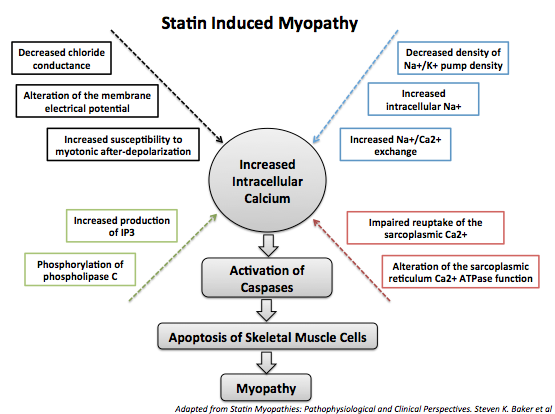Statin induced myopathy
Editor-In-Chief: C. Michael Gibson, M.S., M.D. [1]; Associate Editor(s)-in-Chief: Rim Halaby
Overview
Definition
Statin induced myopathy is a spectrum of muscular problems caused by the intake of statin. Myopathy by definition is the abnormal function of the muscle. The spectrum of statin induced myopathy includes:
Myalgia
- Myalgia is defined as one or combination of muscle weakness, tenderness or pain.
- Patients usually complain of cramping feeling in the muscles.
- Creatine kinase may be normal or minimally elevated.
Asymptomatic increase in creatine kinase
Myositis
- Myositis is the inflammation of the muscle characterised by muscular complaints in the setting of elevated creatine kinase up to ten folds.
Rhabdomyositis
- Rhabdomyositis is the acute degeneration of the skeletal muscle.
- It is a potentially lethal condition due to its associated nephrotoxicity caused by myoglobinuria and myoglobinemia.
- Creatine kinase is elevated in rhabdomyosistis similarly to myositis.
- The complications of rhabdomyositis are acute tubular necrosis, hypocalcemia, hyperkalemia, metabolic acidosis, hyperuricemia, DIC and cardiomyopathy.[1]
Other Statin Induced Myopathies
- Elevated creatine kinase after statin withdrawal[2]
- Autoimmune myopathy requiring immunosuppressive therapy[3]
Prevalence
The prevalence of statin induced myopathy, described as a spectrum of clinical conditions ranging from myalgia to myositis and rhabdomyolysis, is almost 10-15%[4]
Risk Factors
Pathophysiology
Statin induced myopathies has a complex poorly understood multifactorial pathophysiology. It is postulated that statin causes myopathy through the following changes:
- Changes in cholesterol content and alteration of the membrane fluidity of skeletal muscle cells which disrupts their normal function
- Changes in skeletal muscle cells membrane electrical properties
- Changes in Na+/K+ pump density resulting in decreased production of ATP
- Changes in the excitation-contraction coupling
- Changes in the cell surface receptor transduction cascades
- Decreased synthesis of ubiquinone (Q10), a component of the mitochondrial electron transport chain, leading to decreased ATP production and decreased free radical scavenging
- Increased intracellular calcium causing apoptosis of the skeletal muscle cells[1]
- Decreased mevalonate metabolism products, particularly isoprenoids, leading to a chain of events that culminate in apoptosis of skeletal muscle cells[5]
- Shown below is an image depicting the mechanism of statin induced myopathy through increasing the intracellular calcium concentration.

Treatment
References
- ↑ 1.0 1.1 Baker, S.K. & Tarnopolsky, M.A. (2001). Statin myopathies: pathophysiologic and clinical perspectives. Clin. Invest. Med., 24(5): 258-272.
- ↑ Thompson PD, Clarkson P, Karas RH (2003). "Statin-associated myopathy". JAMA. 289 (13): 1681–90. doi:10.1001/jama.289.13.1681. PMID 12672737.
- ↑ Radcliffe KA, Campbell WW (2008). "Statin myopathy". Curr Neurol Neurosci Rep. 8 (1): 66–72. PMID 18367041.
- ↑ Harper CR, Jacobson TA (2010). "Evidence-based management of statin myopathy". Curr Atheroscler Rep. 12 (5): 322–30. doi:10.1007/s11883-010-0120-9. PMID 20628837.
- ↑ Dirks AJ, Jones KM (2006). "Statin-induced apoptosis and skeletal myopathy". Am J Physiol Cell Physiol. 291 (6): C1208–12. doi:10.1152/ajpcell.00226.2006. PMID 16885396.